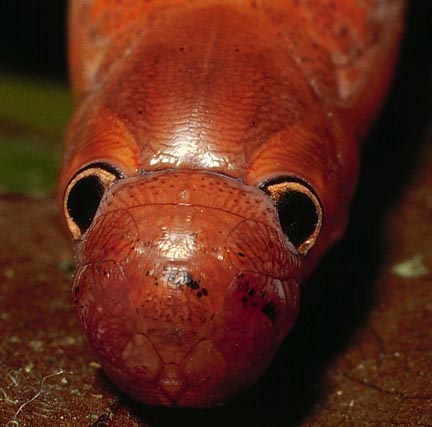What Meets The Eye May Not Actually Be An Eye
/https://tf-cmsv2-smithsonianmag-media.s3.amazonaws.com/filer/97-SRNP-4423-DHJ42568-copy.jpg)
We've got news for all of Costa Rica's insect-eating birds: Those fierce eyes that popped out of the foliage may not actually belong to a snake. They likely belong to an insect just inches tall.
Hundreds of species of butterflies and moths in Costa Rica have evolved to develop markings or "false eyes" that trigger an instant reaction in their bird predators to make them fly away, according to a study published last week in the Proceedings of the National Academy of Sciences by University of Pennsylvania scientists, and husband-and-wife, team Dan Janzen and Winnie Hallwachs, along with John Burns, the curator of lepidoptera at the National Museum of Natural History.
The form of mimicry was studied over several decades in the Área de Conservación Guanacaste in northwestern Costa Rica, where Janzen and Hallwachs have trained native Costa Ricans to gather the insects from the forest and raise them. The study argues that the caterpillars have actually manipulated birds' instinct, over time, to avoid potential predators.
We spoke with John Burns in his office at Natural History, where he explained how exactly such tiny creatures can make much larger bird predators head for the hills.
Tell us a little of the history of insect mimicry?
One is what’s called Batesian mimicry, proposed around 1852 by Henry Bates, an English naturalist who spent a lot of time in the Amazon. He noticed that many butterflies looked like other butterflies even though they weren’t really closely related. He figured out that many butterflies that had showy color patterns were using these color patterns as a warning to the fact that they were distasteful, or poisonous. Birds would learn to leave these kinds of color-patterned butterflies alone, which they learned by trial and error: Eating the butterflies would make the birds sick. So Bates realized that through evolution, there were perfectly edible, non-toxic butterflies who looked almost exactly like, if not exactly like, these poisonous butterflies, and the non-toxic butterflies were copying, or mimicking, them and thereby gaining a degree of protection from their potential predators.
What did your recent study find?
In this case with Dan Jenzen, we’re studying caterpillars. Daniel Janzen and his wife, Winnie Hallwachs, are rearing many lepidoptera caterpillars in the Área de Conservación Guanacaste in northwestern Costa Rica. They’ve been doing this for a few decades now. They actually have a huge team of trained Costa Ricans who go out into the forest and hunt for the caterpillars and bring them back and rear them individually to the adult stage. Many of the caterpillars, and the pupa they turn into as they metamorphose to butterflies, develop paired structures that look like the eyes of a snake, or a vertebrate animal. Now most of these caterpillars, or pupa, are perfectly good food for the small insectivorous birds that feed on them. But if you can imagine a small bird suddenly coming across a pair of eyes on something it’s thinking about attacking, it’ll have second thoughts because those eyes might belong to a snake or a larger bird that would attack it and it would become the prey. We figured out that the birds would have to be already genetically programmed to fly away when they are faced with these false eyes. Much earlier in evolution birds have run up against this kind of threat and if they’re caught, they’re killed, so the birds have developed this innate response—an instant startle and a fear flee reaction. Because if they hesitate in this kind of real situation and decide, “Well you know is that something I can eat, or is that going to hurt me?” In that instant they might get killed. It’s in the bird’s favor to reject that little piece of food and go look for another one rather than linger. This is a form of mimicry—the development of eyes that aren’t real eyes—but it’s not a case where birds have to learn to leave these alone. They are already genetically programmed to do that.
So what do these eyes look like?
Actual caterpillar eyes are tiny little structures, they don’t look anything like eyes as we know them, or like vertebrae eyes. They are just very small structures several on each side of the head. But the false eyes we’ve seen, there's been everything from a pair of little black dots that are sort of the beginning of a suggestion of eyes, to ones that are just extraordinarily complex. There can also be features of the body surrounding the false eyes that will even resemble that of the birds’ predator. There are a few pupa who have markings that look just like the scales of a snake and it’s just amazingly good mimicry. It usually is not that well advanced.
How does this study help the evolution of birds and insects? What does it do for future research?
I would say it’s an interesting result of evolution so far, that this kind of thing has arisen. I can’t say exactly where it’s going except that it will certainly persist as long as birds look for caterpillars. I can imagine over time in many species that the false eyes that caterpillars have may look more and more like an eye—not like those of another caterpillar or any particular kind of snake, but it may become a better copy.
To learn more about the caterpillars and conservation efforts to save their environment, visit Dan Jenzen's Web site.
/https://tf-cmsv2-smithsonianmag-media.s3.amazonaws.com/accounts/headshot/erica-hendry-240.jpg)

/https://tf-cmsv2-smithsonianmag-media.s3.amazonaws.com/accounts/headshot/erica-hendry-240.jpg)